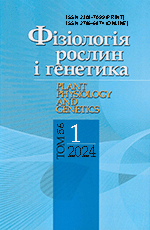Вивчали вплив позакореневого підживлення карбамідом на початку репродуктивного розвитку на інтенсивність фотосинтезу, активність антиоксидантних ферментів хлоропластів прапорцевого листка, продуктивність і білковість зерна сучасних сортів озимої пшениці. Встановлено, що за поліпшення забезпеченості рослин озимої пшениці азотом підвищувались вміст хлорофілу в листках, інтенсивність фотосинтетичної асиміляції СО2 протягом періоду наливання зерна, в кінцевому підсумку це сприяло підвищенню його продуктивності та білковості. В разі підживлення карбамідом зростала активність супероксиддисмутази (СОД) та аскорбатпероксидази (АПО) в період наливання зерна, що супроводжувалося зменшенням вмісту активних форм кисню (АФК) у тканинах листка й, очевидно, підтримувало його функціонування як донора фотоасимілятів.
Ключові слова: Triticum aestivum L., озима пшениця, фотосинтез, карбамід, супероксиддисмутаза, аскорбатпероксидаза
Повний текст та додаткові матеріали
У вільному доступі: PDFЦитована література
1. Kiriziy, D.A., Sokolovska-Sergienko, O.G. & Stasik, O.O. (2014).Carbon dioxide gas exchange in the light and chloroplasts antioxidant enzymes activity of winter wheat flag leaves. Fiziolohiia i biokhimiia kult. rasteniy, 46, No. 2, pp. 121-135 [in Russian].
2. Kyriziy, D.A., Stasik, O.O., Pryadkina, G.A. & Shadchina, T.M. (2015). Photosynthesis: assimilation of CO2 and mechanisms of its regulation. Vol. 2. Kiev: Logos [in Russian].
3. Morgun, V.V., Sanin, Ye.V., Shvartau V.V. (2015). Club 100 centners. Kiev: Logos [in Ukraine].
4. Kolupaev, Yu.E., Karpets, Yu.V. & Oboznyi, A.I.(2011). Antioxidant system of plants: participation in cell signaling and adaptation to the action of stressors. Visn. Kharkiv nat. agrarian un-tu. Ser. Biologiia, 1 (22), pp. 6-34 [in Russian].
5. Morgun, V.V. & Kiriziy, D.A. (2012). Prospects and modern strategies for improving the physiological signs of wheat to improve its productivity. Fiziolohiia i biokhymiia kult. rasteniy, 44, No. 6, pp. 463-483 [in Ukraine].
6. Morgun, V.V. & Priadkina, G.A. (2014). Efficiency of photosynthesis and prospects for increasing the productivity of winter wheat. Fiziolohiia rastenii i genetika, 46, No. 4, pp. 279-301 [in Russian].
7. Pochinok, V.M. & Kiriziy, D.A. (2010). Productivity and quality of wheat grain in connection with the peculiarities of the distribution of nitrogen in the plant. Fiziolohiia i biokhymiia kult. rasteniy, 42, No. 5, pp. 393-402 [in Ukraine].
8. Sokolovska-Sergienko, O.G., Kiriziy, D.A. & Polishchuk, A.I. (2014). The intensity of carbon dioxide gas exchange in the light and the activity of the antioxidant enzymes of wheat leaf chloroplasts, depending on the level of mineral nutrition. In Relevance of the ideas of V.N. Khitrovo in the study of biodiversity of Russia (pp. 251-255), Orel: Acad. Press [in Russian].
9. Mokronosov, A.T. & Kovalev, A.G. (Eds). 1989. Photosynthesis and bioproductivity: methods for determining. Moscow: Agropromizdat [in Russian].
10. Asada, K. (2006). Production and scavenging of reactive oxygen species in chloroplasts and their functions. Plant Physiol., 141, No. 2, pp. 391-396. https://doi.org/10.1104/pp.106.082040
11. Barraclough, P.B., Lopez-Bellido, R. & Hawkesford, M.J. (2014). Genotypic variation in the uptake, partitioning and remobilisation of nitrogen during grain-filling in wheat. Field Crops Res.,156, pp. 242-248. https://doi.org/10.1016/j.fcr.2013.10.004
12. Chen, G.-X. & Asada, K. (1989). Ascorbate peroxidase in tea leaves: occurrence of two isozymes and the differences in their enzymatic and molecular properties. Plant Cell Physiol., 30, No. 7, pp. 987-998.
13. Foyer, C.H. & Shigeoka, S. (2011). Understanding oxidative stress and antioxidant functions to enhance photosynthesis. Plant Physiol., 155, pp. 93-100. https://doi.org/10.1104/pp.110.166181
14. Giannopolitis, C.N. & Ries, S.K. (1977). Superoxide dismutase. Occurrence in higher plants. Plant Physiol., 59, No. 2, pp. 309-314. https://doi.org/10.1104/pp.59.2.309
15. Gill, S.S. & Tuteja, N. (2010). Reactive oxygen species and antioxidant machinery in abiotic stress tolerance in crop plants. Plant Physiol. Biochem., 48, pp. 909-930. https://doi.org/10.1016/j.plaphy.2010.08.016
16. Weather and climate. Retrieved from http: // pogodaiklimat.ru/
17. Kramer, D.M. & Evans, J.R. The importance of energy balance in improving photosynthetic productivity. Plant Physiol., 155, No. 1, pp. 70-78. https://doi.org/10.1104/pp.110.166652
18. Logan, B.A., Kornyeyev, D., Hardison, J. & Holaday, A.S. (2016). The role of antioxidant enzymes in photoprotection. Photosynth. Res., 88, No. 2, pp. 119-132. https://doi.org/10.1007/s11120-006-9043-2
19. Mignolet-Spruyt, L., Xu, E. & Idanheimo, N. (2016). Spreading the news: subcellular and organellar reactive oxygen species production and signaling. J. Exp. Bot., 67, No. 13, pp. 3831-3844. https://doi.org/10.1093/jxb/erw080
20. Munne-Bosch, S., Queval, G. & Foyer, C.H. The impact of global change factors on redox signaling underpinning stress tolerance. Plant Physiol., 161, pp. 5-19. https://doi.org/10.1104/pp.112.205690
21. Sagisaka, S. (1976). The occurrence of peroxide in a perennial plant, Populus gelrica. Plant Physiol., 57, pp. 308-309. https://doi.org/10.1104/pp.57.2.308
22. Vaguseviciene, I., Burbulis, N., Jonytiene, V. & Vasinauskiene, R. (2012) . Influence of nitrogen fertilization on winter wheat physiological parameters and productivity. J. Food Agricult. Environ., 10, No. 3-4, pp. 733-736.
23. Wellburn, A.R. (1994). The spectral determination of chlorophylls a and b, as well as total carotenoids, using various solvents with spectrophotometers of different resolution. Plant Physiol., 144, pp. 307- 313. https://doi.org/10.1016/S0176-1617(11)81192-2
